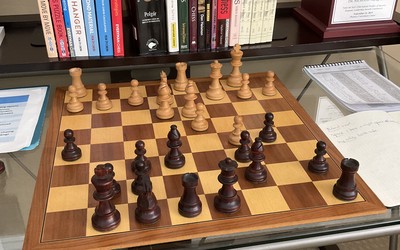
Make It Stick
A review of a non-chess book, but it's pretty useful for chess.
This week I’d like to talk with you about this book, called Make it Stick. Published in 2014, it highlights the surprising conclusions about learning from a 10 year long study. I came to this book after listening to Ben Johnson’s interview with Dr. De Bruin on Episode 39 of the Perpetual Chess podcast. While it is not a chess book explicitly, it is a book about how to learn (which obviously applied to anyone trying to improve at chess). Honestly I cannot recommend it enough. It has fundamentally changed the way I study chess. The key finding from this book boils down to this: To learn you must retrieve. Let’s dive in.
The two researchers (Henry Roediger and Mark McDaniel) were given a 10 year grant to study learning. What they found turned conventional wisdom on its head. Their study was published as this book in 2014. Luck apparently played a role as Peter Brownis a professional writer who just happened to be related to Roediger through marriage. They worked together to try and tell the story of their findings in a way that was accessible to the public. They felt they had an important story to tell and wanted as wide of an audience as possible. The result was this book which is an academic work told by a non-academic author making it very readable.
Before this research, conventional wisdom was that learning was done best by repeated exposure to a single subject. The idea was to focus intently on this one this or aspect and drill it repeatedly until it stuck. This kind of repeated single focused study is called massed practice and was thought to be the tried and true way to learn. There were arguments about the value of testing, optimal difficulty level, and whether students could change their IQ or if they were destined to stay at their level forever. Each one of these areas was full of debate and opinion but short on clear data.
As a physician I’ve taken a lot of tests and spent much of my life studying for exams. Many of these debates were familiar and I lived them. Some students just read books, others took notes and most did both. We would read those notes, underline those notes, highlight passages, and underline the highlighted passages ad nauseam. Maybe you’ve done the same thing. This is a form of massed practice, where the idea is that repeated exposure leads to mastery. Turns out this is dead wrong.
https://substackcdn.com/image/fetch/w_1456,c_limit,f_auto,q_auto:good,fl_progressive:steep/https%3A%2F%2Fsubstack-post-media.s3.amazonaws.com%2Fpublic%2Fimages%2F49a01f9c-4ff1-4a37-bfa4-2d05f8af4c79_1898x624.png
Learning can be best understood as changes in long term memory. Human brains have both short term and long term memory. Short term memory can be understood as a Buddha board, a small stone tablet that you can “paint” with water to make pretty designs that disappear over time as the water evaporates. The key is short term memory evaporates with time and is not retained. Long term memory is more like a stone tablet that is etched with your knowledge. Long term memory is potentially limitless and theoretically permanent but this also will fade over time if not reinforced.
Massed practice is apparently excellent at filling up your short term memory. This will give you the “illusion of mastery” where you believe you have the knowledge but this sort of learning won’t last the night. In the book they highlight a fantastic example of how repeated exposure doesn’t lead to learning. They asked other academics at their institution to point out on a map where the closest fire extinguisher was to their office. Despite having passed by the infernal thing every day for years, very few could successfully recall where they were.
This leads to the author’s fundamental assertion that “learning is misunderstood” (which is the title of their first chapter). They put all their findings and assertions into this first chapter. In fact if all you wanted to do was read this first chapter (#1 out of 8) you’d get nearly all you needed to know from the book which is nicely summarized below.
https://substackcdn.com/image/fetch/w_1456,c_limit,f_auto,q_auto:good,fl_progressive:steep/https%3A%2F%2Fsubstack-post-media.s3.amazonaws.com%2Fpublic%2Fimages%2F884f8669-a536-483c-80bd-c0b4b189dbe3.heic
To learn we must connect the information to knowledge we already have. For example, it’s often said in personal finance circles that “It’s not what you earn, it’s what you keep that matters.” Same with learning, it’s not what you learn but it’s what you retain that matters. Learning is better when it’s personal to you, it’s meaningful, and when it’s concrete. Massed practice is actually none of those things despite its popularity as a studying strategy.
The research showed that the best learning techniques are not what we thought (massed practice) but are counterintuitive. These strategies include:
- Retrieval practice
- Spaced practice
- Interleaving
- Varied practice
Let me try to explain each of these.
To learn you must retrieve. This means you need to do your best to recall the information you learned. Repeated attempts at retrieval signal to your brain that this information is meaningful. The more you retrieve it, the more the pathway to that information is reinforced and easier to recall. The data showed clearly that massed practice filled up short term memory but the learning was forgotten within a short period of time. Students who used retrieval practice however retained the information at much higher rates and much higher accuracy. One example of retrieval practice is flashcards (looking at you Neal Bruce). Another would be simply writing down what you learned, trying your best to summarize the information. However you do it, retrieval practice is far superior to massed practice at making changes in long term memory.
What was even more surprising is the research showed that allowing some forgetting between retrieval practice improves long term retention. This is what’s known as spaced retrieval. The practice sessions need to be spaced out in time to allow the short term memory to clear. This forces the long term memory to be the source. Moreover, simply reviewing notes isn’t enough. Instead you must somehow work the information into relatable pieces of knowledge that you can recall. There is a level of desirable difficulty that is needed to etch the information into your long term memory. Rather than demotivating students, this difficulty helps to make the information meaningful to the learner. How difficult is just right is hard to say. It’s like molding clay before you form it, work is required. How long between sessions is not known, but at least one day to allow forgetting to occur.
Interleaving was a concept I initially struggled to understand. Interleaving means mixing related but different skills or knowledge into your practice at the same time. Instead of practicing one topic again and again, it’s better to mix in different topics that are related into the same session of practice. For example in chess we might do mate in 2 tactics, only to also include calculation puzzles or opening puzzles in the same session. Each chess game is a mix of skills required, but often we practice only one at a time. Interleaving different but related concepts initially feels odd and like you’re not learning enough. But over time, this practice will result in greater retention.
Varied practice is the last item. Instead of practicing the same skill over and over again, the research showed it’s better to mix it up. The example they used was batting practice for a college team in baseball. One experiment took half the team (Group A) and gave them 45 pitches total with 15 fastballs, 15 curve balls, and then 15 change ups. This group had mass practice. The other half (Group B) was given the same 45 pitches, but in random order. This group had varied practice. At the end of the experiment Group A was better at batting practice than Group B. However, Group B was better in the real game. The second group had practiced how to recognize a pitch, while the first group had practiced how to hit a fastball, curve ball, and change up.
It’s hard to overstate this finding. Conventional wisdom was that massed practice was the best way to learn. I imagine this is partly due to the illusion of mastery that learners were subject to. Our brains however evolved to handle a variable, dynamic world with multiple things to pay attention to. Studying in a similar manner apparently helps our brain to retain information faster. That being said, the illusion of mastery will be gone meaning learners may feel they’re not getting enough of any one part.
Taken together these findings turn learning on its head. Instead of honing in on one subject at time, the best way to learn is to mix it up, combing related topics into your study. Testing yourself helps retention better than reviewing notes. Allowing yourself some time between study improves learning. Lastly, all new information must be connect to prior knowledge. Making it personal and meaningful greatly improves retention. Yet, there’s so much more in the book that I’ve left off. Reading through all 8 chapters was revelatory. I strongly recommend any chess learner take some time to read this book (at least Chapter 1).
I felt sad for my younger self, not having access to this information. I might have studied very differently. All I can do is now apply it, and I have. What I’m doing with my chess has changed significantly. How I study chess now will be the topic for my next post. Thanks again for reading and please share this post or leave a comment! Until next time.




